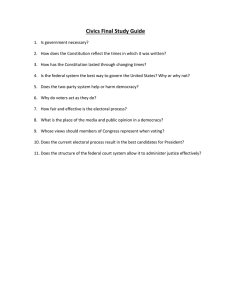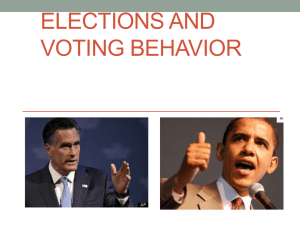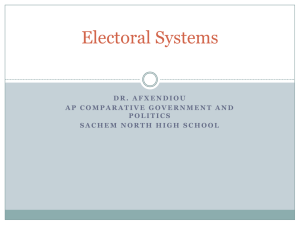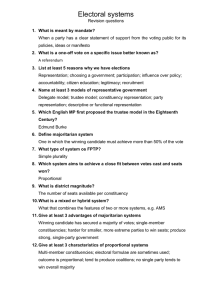New Electoral Systems: What Voters Need to Know by Clarissa White, SCPR
advertisement
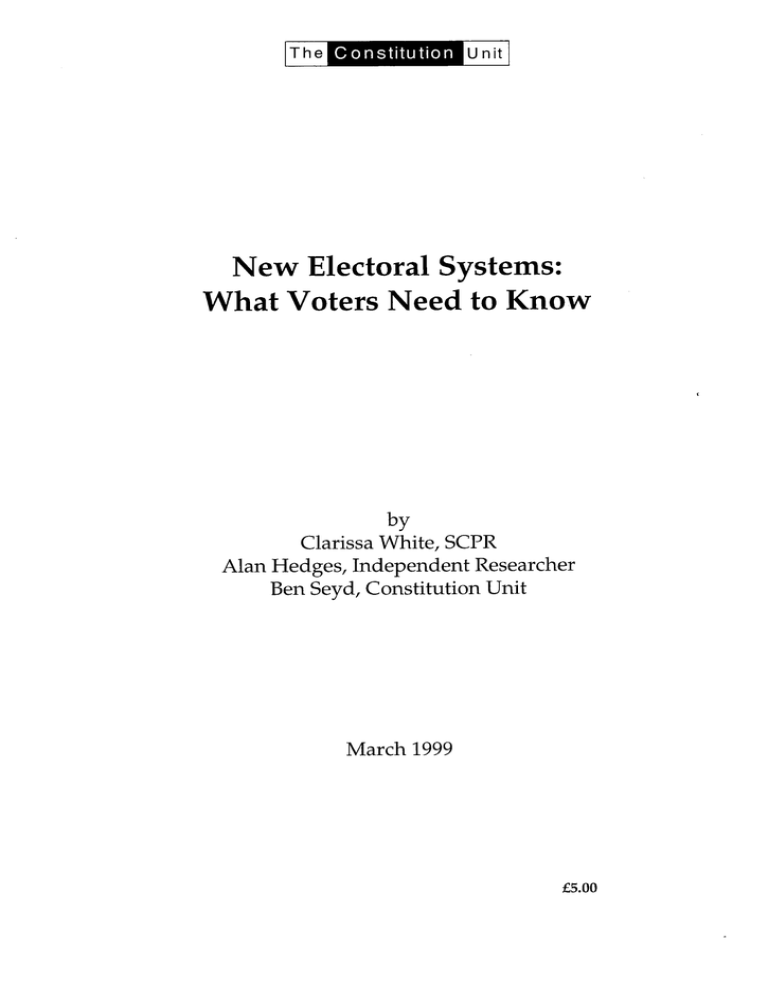
New Electoral Systems:
What Voters Need to Know
by
Clarissa White, SCPR
Alan Hedges, Independent Researcher
Ben Seyd, Constitution Unit
March 1999
Contents
Executive summary .....................
.
......................................
1
Research background and aims
electoral turnout ...............................................................
voter education ..............................................................
existing research on voter understanding ...........................
current research programme ...............................................
3
4
4
4
Attitudes towards electoral systems
views about First Past the Post .............................................6
views about alternative electoral systems .......................... 7
Information on new electoral systems
casting a vote ....................................................................8
the operation of the new electoral systems ......................... 8
the new institutions and electoral boundaries ..................... 10
Delivering system information
the timing of information ...................................................... 11
conveying information ......................................................... 11
avoiding overload ................................................................ 12
Understanding of new electoral systems
Supplementary Vote ........................................................... 13
Regional List system ........................................................... 14
Additional Member system ..............................
.
................ 15
Conclusion .......................................................................... 17
Annex 1 .Explanation of electoral systems .......................
18
References .............................................................................19
Executive Summary
The UK public is facing a spate of elections to be held under new voting systems: to the
Scottish Parliament (May 1999), the Welsh Assembly (May 1999), the European
Parliament (June 1999) and the Greater London Authority (May 2000). This study has
been undertaken to explore how far voters understand the new electoral systems, to
identify what information is needed to help voters to use the systems and to assess when,
and in what form, such information is best conveyed.
Need for system information
The new electoral systems are unfamiliar to most people, and various features are not selfevident or intuitively easy to grasp. Even the basic essentials of the way the systems work
tend to appear complex, and are quite hard for some people to grasp.
Voters will need more than a mechanical knowledge of how to cast their vote under the
new systems. In particular, they will need information that enables them to understand at
least the rudiments of the new systems and the way they work. The issues that need to be
covered are to some extent system specific, although others are generic across the systems
(eg. how votes translate into seats). Voters believe that the provision of high quality
information will help them decide which way to vote, as well as encouraging more people
to cast their ballot.
Voters7find it easier to understand the new electoral systems once the grounds for change
are explained to them. Most voters are familiar with casting their ballot under First Past
the Post (FPTP), and will need help in understanding why this is being replaced at some
elections.
While this information should include guidance on how FPTP operates - which many
people do not fully understand - it should avoid overloading voters with material, nor
should it be overly polemical; voters are suspicious of information that 'over sells' any
new system. This poses difficult questions of balance for any education programme:
between explaining clearly the rationale for electoral system change and the properties of
the new system, while avoiding contentious statements that will deter some voters.
There will also need to be other kinds of contextual information:
details of the new institutions and their roles and powers: while the study found
participants generally seemed at least vaguely aware of the new institutions, there was
little details knowledge about their activities;
details of the new electoral units; voters are usually familiar with being located in
parliamentary constituencies, and will need information about any new units and their
boundaries.
However, voters should not be overloaded with information about the new electoral
systems; while there is a general desire to know how the systems will work, there is a
limited appetite for grappling with the details.
Delivering system information
Informing the public about the new systems will not be easy. The subject of electoral
systems is too dry to arouse much spontaneous interest and the study found that voters
generally have little existing knowledge to build on.
Information about the new systems needs to be delivered well in advance of the election.
People do not want to have to struggle with learning about systems at the point of voting;
they expect their vote to be a rapid execution of decisions largely already taken. If
information about the new systems is not available well before election day, then some
may be put off from going to vote at all.
It will be easier to take in this kind of information if it is drip-fed through a variety of
media over some weeks, rather than being presented in one indigestible lump. People
expect, and want, a serious multi-media information campaign, including TV, press and
other media. Voters will also need official education material that they can trust as being
objective and neutral. At the very least, this should take the form of a series of leaflets
explaining the operation of the new systems, and rationale for adopting them.
Responses to the new electoral systems
Of the three systems tested, the research found that the Supplementary Vote was the most
easily understood. The Regional List system was less obvious to voters, although it was
soon understood once its main features had been explained. The hardest system for voters
to understand (both in relation to the other two systems, and in absolute terms) was the
Additional Member System, in particular the basis and reason for having two votes and the
relationship between each part of the ballot.
Research background and aims
Introduction
This briefing summarises the main findings from a programme of qualitative research
conducted by Social and Community Planning Research and the Constitution Unit, and
funded by the Gatsby Charitable Foundation with financial contributions from the Home
Office, Scottish Office, Welsh Office and Government Office for London. The study was
undertaken:
to explore the design of ballot papers for the forthcoming elections
to assess how far voters understand the new electoral systems; and
to identify what information is needed to help voters to use the systems.
The findings are reported in full in the main research report New Electoral Systems: What
Voters Need to Know, which is published simultaneously with this briefing.' The main
report includes the results from the principal focus of the research, which was to explore
the design of new ballot papers (which are only touched on in this Briefing on page 8).
Electoral turnout
The UK is facing a major change in one of the pillars of its democracy, the electoral
system. In the next two years, three2 new voting systems (Annex 1) will be introduced:
an Additional Member System for elections to the Scottish Parliament, the Welsh
Assembly and the Greater London Assembly
a Regional List System for elections to the European Parliament
the Supplementary Vote system for elections to the post of London Mayor.
The intention behind the new voting systems is to strengthen the representative link
between voters and government, and thus create a more sophisticated and participatory
political culture. But there is a risk of the reverse happening: faced with additional tiers of
government, along with new systems used to elect them, voters may find the arrangements
confusing and offputting, and stay away from the polls. This concern should be placed in
the context of electoral participation rates in the UK which, in some cases, are low by
international standard^.^
1
Available from the Constitution Unit, price £1 5.
Not including the Northern Ireland Assembly, which was elected in June 1998, using the Single
Transferable Vote system.
Turnout for the 1994 European Parliament elections was 36.4% in the UK, as against 52.7% in France,
59.6% in Spain and 60.0% in Germany. Although turnout for local government elections (metropolitan
boroughs, non-metropolitan borougl~sand London boroughs) has increased since 1973 (Bochel et al,
1994), it remains well below that for comparable EU countries (Commission for Local Democracy, 1995).
Voter education
The first elections to the Scottish Parliament and Welsh Assembly, on 6 May 1999, will be
preceded by programmes to educate the public about the new institutions and the electoral
systems being used to elect their members. Both the Scottish and Welsh offices are
committing &2mto these campaigns. There will not, however, be a broad voter education
campaign in advance of the European Parliament elections in June 1999, in spite of
historically low turnout in this contest.
Existing research on voter understanding
Politicians, civil servants and other interest groups can currently draw on only limited data
showing in detail how far UK voters understand the new electoral systems, and what
information they will require in order to participate confidently in elections.
The two main sources of information on voters' reaction to new electoral systems are:
Making Votes Count, a study conducted by Patrick Dunleavy and colleagues, based on
large scale voter surveys conducted in 1997 (Dunleavy et al, 1997). This quantitative
research showed the Additional Member and Supplementary Vote systems to be the ,
preferred alternatives to First Past the Post, as well as being the easiest to understand
for voters;
a qualitative study carried out on behalf of the McDougall Trust by David Farrell and
Michael Gallagher in 1998 (Farrell and Gallagher, 1998). This research addressed more
directly voters' attitudes to, and understanding of, different electoral systems. It found
several specific areas where voters experience confusion in relation to electoral
systems, including: the relationship between votes and seats under First Past the Post,
and the use of multi-member constituencies.
Both pieces of research provide useful information in helping us appreciate how voters are
likely to react to new electoral systems. The Farrell and Gallagher qualitative study is
particularly useful in its exploration of voter understanding of the new systems. Yet,
because the research was also concerned to address a number of attitudinal issues to
electoral reform: it was prevented from exploring levels of voter comprehension in the
detail the issue arguably deserves.
Current research project
This study does not explore in detail voters' attitudes towards First Past the Post or
alternative electoral systems (although some analysis of these issues is included in this
briefing, on pages 6-7). Rather, it concentrates on how far they understand how to use the
new voting systems, and what additional information they require to participate more
confidently in the forthcoming elections. The research was based on a programme of
Such as: knowledge of, and levels of support for, First Past the Post; attitudes towards the practices and
structures that derive in large part from the current electoral system; and levels of support for the criteria
used to assess the desirability of electoral reform, such as proportionality and the retention of single
member constituencies.
focus group discussions and in-depth interviews with individual members of the public,
conducted in various locations in England, Scotland and Wales in late summer 1997
(further details of the methodology used can be found in the main report). The qualitative
approach, unlike mass level surveys, allowed the research to examine in some detail
voters' level of understanding. However, the limitation of using small, though purposively
selected, samples is that the results cannot show how widely the various views are held
amongst the wider voting population.
Attitudes towards electoral systems
Views about First Past the Post
Interest in electoral systems among the public is generally low. The mechanics of different
electoral systems are seen as being an abstract and boring subject with little relevance to
the majority of the voting public. Knowledge of the various systems is usually very
limited.
The current electoral system is generally familiar to voters, although the name 'First Past
the Post' is not always recognised. On one level it seemed well understood, commonly
described as a system where 'the person with the most votes in the constituency wins'.
However there is typically much less understanding of the way in which votes translate
into seats at the aggregate level; the distinction between the 'share of vote won' and 'share
of seats gained' (ie. the proportionality of the system). Similarly, when it comes to the
formation of a government under FPTP, voters do not seem to appreciate the distinction
between 'plurality' and 'majority' in terms of the share of vote needed to win under FPTP.
Knowledge about the way in which the electoral arithmetic is calculated is important, since '
it can influence people's attitudes to FPTP as an electoral system. We found that voters
who did not appreciate the plurality nature of FPTP were much less likely to view the
system as unfair. Indeed, it seemed that until this point is made clear, these people may be
unlikely to embrace an alternative voting system. Among our sample, desire for change
was often, but not exclusively, voiced by participants with more awareness and
understanding of the way in which FPTP produces overall outcomes. These people were
also more aware of the existence of alternative voting systems to FPTP.
Among our sample, the following reasons were usually given in support of FPTP's use in
parliamentary elections:
its familiarity, and perceived longevity of use;
its provision of a direct link in each constituency between voters and their
representatives.
The main reasons given against FPTP as the voting system for parliamentary elections
were:
its perceived unfairness in allowing parties to win elections with less than 50% of the
vote;
the under-representation of minor parties that it is perceived to cause (the 'vote share':
'seat share' disparity highlighted above);
the high number of perceived 'wasted' votes that it encourages, particularly in safe
seats ('electoral insulation', where a constituency is dominated by one party or
candidate, was also felt to discourage voting).
Views about alternative electoral systems
There is some awareness among voters that alternative voting systems exist, but not
generally a great deal of understanding of what the alternatives are, or how they work.
The term 'proportional representation' seems fairly familiar, but what it actually means is
often not well appreciated.
The main appeal of the alternative electoral systems is their perceived fairness; for some,
these systems are seen to be fairer even in the absence of real understanding of how they
work, although some voters put forward more specific arguments in their favour, based on
the plurality-majority distinction. The perceived limitations of proportional electoral
systems usually relate to their complexity and their supposed propensity to over-represent
minority parties and produce coalition governments.
Information on new electoral systems
Casting a vote
To be able to take part at all in the ballot, people need basic information about the
mechanics of voting: how many votes do I have? where do I put them on the ballot paper?
if there is more than one vote, which vote relates to which element of the election? what
kind of mark do I make?
Voting instructions like these are essential, but our study suggests they are usually fairly
easily supplied. People were generally able to pick up information of this kind from most
of the test ballot paper designs without prior explanation. They did not usually feel that
they were being set a very difficult task, and when asked to 'vote' they seldom marked
their papers in invalid ways.
This is because, at a mechanical level, voting in these new systems is not very different
from what people are used to doing under FPTP. The Additional Member and
Supplementary Vote (SV) systems have two votes instead of one, and SV involves making
a second choice; but otherwise the actual ballot papers function much as before.
However, this does not mean that ballot paper design is unimportant; the main report
reviews various different designs, and concludes with pointers to good practice.
Nevertheless participants' principle difficulties and concerns were not with voting
instructions, but with the workings of the new systems themselves.
The operation of the new voting systems
It might have been the case that, as long as voters felt confident about the mechanics of
casting their vote, they would not have cared much about the way the system works. But
the study generally found quite the opposite attitude. There was a clear and fairly
consistently expressed desire to understand the operation and implications of the new
voting systems before deciding how to vote. This, it was argued, might inform the way a
person voted, or possibly encourage more people to vote.
Moreover, participants required explafiations of various features of the new systems, such
as having two votes, expressing a second preference, or voting for a party rather than an
individual candidate. Participants in the study sessions, asked to 'vote' without prior
information about these and other features of the systems, often felt unsure about what
they were doing, even though they were quite clear about the mechanics of casting their
vote. (The particular features of the new electoral systems on which voters require
specific information are discussed on pages 13-16.)
Voters will need information about the new electoral systems because:
'
These are the first major changes to the electoral system experienced by most British
voters, and the mere fact of change in a hitherto stable situation tends to raise questions
in people's minds. Add to this the fact that the new systems (particularly AMS; page
15) are generally neither familiar nor intuitive, which often makes people feel they do
not know what they are doing when they vote;
Some basic understanding of the system might affect the way they want to vote
(especially given voters' perceptions of 'wasted' votes under FPTP, and the
opportunities for different voter behaviour that the new two vote systems will present).
People's desire to learn about the systems themselves does not arise from intrinsic interest
in the subject; on the contrary, electoral systems usually strike people as an arid and
abstract topic, certainly once they get beyond simple general concepts like 'fairness' and
'wasted votes'. Indeed, some tensions became apparent during the study sessions, with
people wanting to know the answers to questions on system properties, but often finding
the job of trying to master the information both tricky and tedious. 'Wanting to know' is
not necessarily the same as being 'motivated to find out' (this reinforces the point about
the need for a well designed and imaginative education campaign).
Information about the rationale for, and properties of, new electoral systems is harder to
convey than instructions on the mechanics of casting a vote. Well designed ballot papers
are usually fairly easy to master, but the systems they represent are more intricate and
harder to explain. For example, it is comparatively easy to state the fact that electors have
two votes, and to show where these are to be expressed on the ballot; but it is often much
more tricky to explain why there are two votes, how they fit together and how they
determine the outcome of the election.
Our study participants seemed to find it easier to pick up, and focus on, the key features of
the new systems once they understood what the reforms are trying to achieve. Where the
reforms seemed an arbitrary procedural change, they seemed less motivated to persevere
in trying to understand them. For example, participants found it easier to understand the
two different layers of AMS if they grasped that this aims to balance FPTP's element of
direct local representation with a fairer distribution of seats in relation to votes.
Since the new systems usually seemed more complex than FPTP, participants sometimes
expressed the desire for an explanation which justifies the need for change; otherwise the
shift from a simpler to a more convoluted procedure is simply puzzling to those using it.
People are less likely to engage with a new system if they are unclear about why it has
replaced FPTP.
However, our study found some participants who reacted against accounts justifying
electoral system change which seemed to be trying to 'sell' the new system. This poses
difficult questions of balance, since people will require neutral information about a reform
that is the subject of intense political controversy. What is required is information that
explains clearly to voters hotly contested notions such as 'making everyone's vote count'
and 'a fair allocation of seats', while avoiding polemical statements that might compromise
its objectivity and deter some voters.
The new institutions and electoral boundaries
Electoral change has followed the establishment of new institutions, in Scotland, Wales
and London. The European Parliament is not new, but many people are ignorant of its
role and operations, and as a result feel remote from it (NOP, 1998). Our study sessions
seemed to reinforce the bleak picture that appears from the low turnout figures for EP
elections quoted above (footnote 3); people are less inclined to go to the polling station if
they are not sure what they are voting about, what the issues are, or who the candidates
are.
Although the study participants generally seemed vaguely aware of the new devolved
institutions, with some being quite well informed, there was little detailed knowledge of
their roles, powers and activities. Participants were clear that they both need, and want,
such information before voting.
Voters will also require information on any new electoral boundaries being used in the
forthcoming contests. Some of the new electoral divisions will be very different in scale to
those currently used in parliamentary and European elections, and the new units need to be
identified."erms
such as 'constituency' are strongly associated with Westminster
elections, and need to be explained if used in the context of different elections. Even
descriptions such as 'region' are problematic, since many people do not know the
boundaries to their region or are even confused about which region they fall into. At a
specific level, we found participants in Scotland making associations with the former
regional councils; and many participants in London found it difficult to think of their city
as a 'region' at all.
AMS in Scotland and Wales will use parliamentary constituencies for the first section of the ballot, and
regions (Scotland: 7 regions, each electing 8 members/Wales: 5 regions, each electing 4 members) for the
'top up' section. The inembers of the Greater London Assembly will be elected from 14 electoral areas
(amalgamations of 2-4 London boroughs), or from a London-wide top up list. The electoral units for the
European Parliament contest will be the standard regions of the UK, with Merseyside incorporated into
the North West.
Delivering system information
This section considers when, and how, people want information on the new electoral
systems to be delivered.
The timing of information
Explanation of the way new voting systems work is wanted much earlier than instructions
on how to vote. Voters will not expect to be learning about system operation in the
polling station. They largely expect to decide how to cast their ballot before going to
vote, although some may fine-tune or review their options in the polling booth. Some
people are less likely to vote if they feel uncertain about what they are doing; our study
found that voters need to have information on the electoral systems in order to achieve
their objectives, and that the absence of such material is an important source of voter demotivation. People also want the act of voting to be quick and simple, essentially an inout process, and did not want or expect to have to spend time at the polling station
absorbing information.
People will also need information early because there is a lot to take in. Our study showed
that many voters will find it hard to absorb quickly all the information on the new systems;
particularly for AMS (page 15). Voters will thus need to have access to system
information:
well in advance of the poll: periods of a month or more in advance were suggested
on a 'drip feed' basis, so they can absorb it over time.
Conveying information
Our study participants looked to the media as a prime point of information on the new
institutions and electoral systems. The main source was seen as being television, with
radio and the press also highlighted. However, many participants 'switched off' when
politics was covered in the media, and it is clear that a range of alternative sources of
information will also be required.
Participants were also clear that the information they expected, and needed, should be
neutral, and not favour one political side or the other. There was some suspicion of the
role of political parties in providing explanatory material; participants indicated that they
would place greater trust in an official information programme that would present the
issues in an objective manner. Such a programme should involve not only leaflets, but also
some form of interactive learning (eg. a telephone helpline, and organised public
meetings). The diagram below indicates the main information flows that will be required,
along with the form that these should take.
'
I1
New elections: main desired information flows
Solid arows denote key flows, dotted arrows subsidiary flows
Avoiding overload
It would be easy to draw up a lengthy wish-list of things voters would like to know, but
our study clearly demonstrates the vital importance of avoiding information overload.
This was apparent both from what people said (frequent requests to "Keep it simple"), and
from the way they reacted to the information provided (often giving up their attempt to
absorb the information before they had really extracted what they wanted to know).
The study participants consistently found the subject matter quite difficult, and although
they felt it important to know how the electoral systems work they didn't find the
mechanics intrinsically interesting. There seem to be two solutions to this:
"Drip-feeding" information over a period of time, so that the key ideas can be
absorbed gradually
Making information available at different levels, so that people can engage with the
systems according to their own interests and abilities. Some want to know more than
others, and information which is sufficiently detailed to satisfy more enquiring minds
may be inaccessible to those who find the basic details difficult to internalise.
However, there needs to be a basic bedrock of very simple and effective information, with
the essential story pared down to its core essentials.
Understanding of the new electoral systems
It was not the purpose of our study to explore in detail voters' attitudes to the new
electoral systems. Rather, our interest was in how well they understood the systems, and
what information needs they had. Other quantitative (eg. Dunleavy et al, 1997) and
qualitative (eg. Farrell and Gallagher, 1998) studies have covered voter attitudes in detail.
This section, then, focuses on issues of comprehension, although, as our study inevitably
touched on voters' attitudes to the new systems, these are also discussed briefly.
Supplementary vote
Supplementary Vote (SV) was discussed only in London, where the examples were based
on the election for the Mayor.
Comprehension: Voters found SV the easiest to understand of the three systems, and few
significant problems were encountered in explaining it.
Key points to understand: The key points necessary for understanding SV are:
The existence of, and rationale for, two votes
What happens to the second vote, particularly when and how it is used. This was
not obvious without explanation, and some of the study participants found SV more
convincing once they understood that second votes were only counted when no
candidate got an immediate majority of first preferences
What happens if no candidate gains 50% of first and second preferences (the
rationale for the system being that it produces a winner commanding an overall
majority of votes).
Difficult points to explain: The only difficult point to get across was how and when the
second votes are used.
Additional explanatory points: It should be made clear to voters whether they have to use
their second vote. Some of the study participants queried whether their ballot paper
would be invalid if they only made a first choice, which some were inclined to do.
Attitudes towards the Supplementary Vote: Participants seemed to like SV fairly well,
particularly when the use of second votes is understood. Voters respond positively to the
fact that the winners are likely to have majority support. However, some saw no
advantage in having a second choice, the rationale for which will need clear explanation.
The less appealing features of SV were the unfamiliarity of the system, and the confusion
for some over how it works. SV was generally seen as slightly more complicated than
FPTP. There was also some concern that second preferences might outweigh first
preferences; in other words, that a candidate with a good first choice performance might
be beaten by another candidate after second choice votes had been taken into account.
Regional list system
Exploration of the Regional List System (RLS) was based on European Parliament
elections in all areas, using the closed list variant in which voters choose parties, not
individual candidates.
Comprehension: This system was generally thought to be a bit harder to understand than
SV, with participants finding it less straightforward and intuitive. Voting for a party slate,
rather than an individual candidate, was a new concept that people found hard to absorb.
Key points to understand: The central points to understand about closed-list RLS are:
The basic concept of a closed list system:
- that you vote for a party (or independent) not an individual candidate on a party
list
- that the parties, rather than the voters, decide who will fill the seats won by each
party.
How the seats are allocated to parties: that this operates on a broadly proportional
basis, with the share of seats roughly matching the share of votes each party wins.
How it is decided which candidates fill each party's seats: that they are taken from the
top of the party list, and that the order of listing is therefore important.
DifSicult points to explain: The points about RLS that caused difficulty were:
How seats are actually allocated. This seemed generally to be readily grasped once it
was explained, but respondents needed more information than simply using terms like
'proportional'. And, when it comes to entitlements to fractions of a seat, the simple
image of sharing seats out in proportion to votes does not work. The explanations
as it was felt this was far too
given did not address the dYHondtelectoral arithmeti~,~
complex for a basic first-time communication of the system. However, this kind of
information should be readily available to those who want and can make use of it,
since at this level the system may not function quite as the 'top-line' picture implies.
The existence, and operation, of thresholds. Some study participants wanted to know
whether there is a minimum level of vote below which minority parties would get no
seats. With the exception of the elections to the Greater London Authority (where the
government is expected to introduce a threshold of 5%), none of the forthcoming PR
elections will apply a formal threshold. However, de facto thresholds - the minimum
' D'Hondt is the name given to the method by which parties'
entitlement to seats is calculated. It involves dividing the total number of
votes received by each party by a series of divisors (1, 2, 3, 4, ...) to reach, at each stage, an average number of votes for each party. The
number of stages is detennined by the number of seats up for grabs; whichever party has the highest average vote at each stage wins that
seat. The important point for voters to understand is that parties' entitlement to fractions of seats is determined by the 'highest average'
concept, so that whichever party has the highest average vote at the last stage is allocated the final seat.
level of support that parties need to get to gain one seat - do exist. It would be
worthwhile conveying this information to voters.
The rationale for the closed list, and why it is not possible to vote for individual
candidates.
Additional explanatory points: Proportionality is approximate rather than exact; parties
cannot win fractions of a seat, and constituencies with small numbers of members may not
see a very good fit. This point was not stressed in the explanations given to respondents,
but it is important not to give people unrealistic expectations of exact proportionality.
Attitudes towards the Regional List system: Responses to RLS were mixed, although
generally fairly positive. As with SV (and AMS), people responded favourably to its
perceived superior fairness than FPTP. The less appealing features of RLS related mainly
to the 'closed' nature of the lists, with many participants finding it unsettling to have to
cast a 'party' vote without being able to choose individual candidates (particularly if the
top candidate was not liked, or a low placed candidate well liked). Closed lists were
widely unpopular among participants, because they were seen to shift power from voters
to parties and cause confusion over which candidates would be elected. The 'closed' ,
nature of the lists tended to weaken the appeal of RLS for the study participants.
Additional Member System
The Additional Member System (AMS) was explored in all areas, using the devolved
assemblies as examples.
Comprehension: Study participants found AMS the hardest of the three systems to
understand. This was a consistent response across different sessions in all areas, and
changing the explanatory text given to participants before or after they 'voted' seemed to
make little difference. The basic concept behind AMS was not obvious or intuitive, and
participants found some of the mechanisms hard to grasp in detail. Some were surprised
at how complex it is, and found it over-complicated.
Key points to understand: The central points for voters about AMS are:
That the two votes correspond to two distinct elements of the system
The nature of each element: a local candidate-based element and a regional partybased eIement
The similarities and differences between them: that local members are intended to
provide a direct constituency link and are elected as individuals by a FPTP ballot, and
that regional members are meant to ensure a fair overall distribution of seats between
AMS was also tlie system for which it was hardest to write a simple explanation, and some of the
versions tried during the study did not perform well. But participants' difficulties were not merely due to
inadequacies in the texts.
the parties, and hence are elected by a party-based vote through a PR regional list
system (as for RLS)
How the elements fit together in determining the outcome of the election: the share of
votes is based only on the regional poll, whereas the share of seats takes the local, as
well as regional, seats into account
The status, role and powers of the two different 'types' of member.
Dzfficult points to explain: The most difficult feature of AMS was the intrinsic complexity
of the system, and in particular the way seats are allocated.
The local FPTP element was usually straightforward and familiar to participants.
Difficulties related more to the regional element, and particularly to the combination of the
two. In principle, regional AMS should not be much harder to understand than RLS, but
in practice it seemed to cause more trouble because AMS brings together what seem to be
two disparate elements. There was widespread difficulty understanding the basis and
rationale of the regional and local votes, and how they relate to each other. Participants
readily understood that they had two votes, but usually found it harder to grasp the way
they fit together to produce a particular outcome.
,
Use of the concept of 'topping up' the vote did not seem to be helpful unless people had
grasped what it was being topped up to;in other words had understand the basic concept
of proportionality. It was sometimes assumed that members elected under the two
different parts of the ballot would have different powers, responsibilities or status; or even
that they might sit on different bodies.
The fact that some individual candidates may stand at both local and regional level was
difficult for many participants to rationalise. It sometimes appeared vaguely illicit, and
some commented that it would enable parties to procure a regional seat for an individual
who might have been rejected by the electorate at local leveL8
Additional explanatory points: As for RLS, it should be made clear that proportionality is
approximate. Participants usually assumed that they did not have to choose the same
party at both levels, but this may be worth stating explicitly on the ballot paper.
Attitudes to the Additional Member System: Once they had understood the way it works,
some people thought AMS offered the best of both worlds: a direct link to a local
representative, combined with a fair overall distribution of seats. However this aspect was
not usually apparent unless and until the basic structure and rationale had been clearly
grasped. The less appealing features of the AMS system were its complexity and the
closed nature of the list.
Candidates will, indeed, be able to stand on both parts of the ballot in each of the AMS elections.
Conclusions
The main findings that emerge from this study are set out below. In the main they relate
to the nature and complexity of the systems, rather than to any particular design elements.
The main exception arose in relation to the list systems, where the 'closed' nature of the
lists was widely unpopular among participants. The main general points that emerged are:
the low level of knowledge about electoral systems; in particular, the operation of First
Past the Post and alternative systems, plus the meaning of terms such as 'proportional'
and 'proportional representation';
the negative impact this limited understanding has on voters' awareness of the merits of
alternative electoral systems. People who do not appreciate the plurality nature of First
Past the Post are less likely to view the system as unfair, and may be unlikely to
embrace an alternative voting system;
the need to explain to voters the rationale for changing the electoral system. Such
explanation makes it easier for voters to understand the key features of the new
systems. Where electoral reform is seen as being an arbitrary procedural change, voters
appear less motivated in trying to understand it;
that voters should have few problems in casting their ballot under the new systems, as
the actual method of voting under these systems is quite similar to that under First Past
the Post;
that to use the new systems, voters require information that goes beyond the mechanics
of casting a ballot. People need to know about the basic operation of the new systems,
in particular how votes get translated into seats. Adopting new voting procedures
raises questions in people's minds, and they are uncomfortable about being asked to use
a system whose operation they do not understand;
information about the working of the electoral system is needed in relation to each of
the systems being introduced shortly: the Supplementary Vote, Regional List and
Additional Member systems. The last is particularly difficult for voters to understand,
both in relation to the other two, and in absolute terms;
the need to provide information well in advance of polling day. People do not want to
learn about the electoral system in the polling station; they want information at least
one month prior to the election. This information should be 'drip fed', so that voters
have several chances to engage with it; also, it should be delivered through a variety of
sources, and at several different levels to fit in with people's varying learning abilities
and desire for information.
Electoral systems are seen by voters as being an arid subject. Thus, even during the study
sessions, we found participants7 recognition of their information needs being outstripped
by their lack of motivation to learn the answers. As a result, we do not underestimate the
difficulties in explaining to the public the operation of new electoral systems. This study
suggests that any education programme retains a simple and clear approach to the
presentation of information. Most of all, though, the programme needs to be imaginatively
conceived, and delivered via a variety of sources, if it is to engage voters' attention on the
forthcoming elections.
'
-
Annex 1 Explanation of electoral systems
First Past the Post (FPTP)
House of Commons
Each constituency has one member, and each elector casts one vote. Whichever candidate gains the most
votes wins. There is no requirement for the winner to gain a majority (50%+) of votes, merely the largest
number (or plurality).
Additional Member System (AMS)
Scottish Parlianzent, Welsh Assenzbly and Greater London Assembly
Voters cast two votes: one for a constituency member, the second for a party. Constituency members are
elected as under First Past the Post; parties then win 'top up' seats according to whether they have won
their fair share of constituency seats. It is the share of votes won in the party section of the ballot that
determines what percentage of total seats parties should win. So, if a party wins 25% of the party vote, but
only 15% of constituency seats, it will gain sufficient top up seats to bring its total share to around 25%.
The Scottish Parliatnent will contain 129 members: 73 will be constituency members, with 56 elected
from party lists. The Welsh Assembly will contain 60 members: 40 will be constituency members, with 20
elected from party lists. The Greater London Assembly will contain 25 members: 14 will be constituency
members, with 1 1 elected from party lists.
Regional List System (RLS)
European Parliament
This system involves large multi-member constituencies, in which the parties put forward lists of
candidates. Under the 'closed' list variation, electors can vote only for a party list of candidates, not for
individual candidates. Seats are allocated according to the proportion of the vote won by each party. The
method of allocating seats uses an averaging system, so that each parties' votes are divided by a series of
divisors, with the party holding the largest average number of votes at each stage of the process winning
the seat. The particular divisor method to be used is known as the d'Hondt system.
Supplementary Vote (SV)
London Mayor
This system is used to elect one person, with the aim that helshe should have over 50% of the vote. Each
elector has two votes: a first and second preference. Once all the votes have been cast, the first choice
preferences are examined; if one candidate has gained more than 50% of these votes then helshe is
automatically elected. If, however, no candidate reaches 50% on first preference votes, the two candidates
with the highest percentages of first preference votes go through to a second round. Here, second
preference votes of all the other candidates are examined, and where they are for one of the top two
candidates, they are added to the pool of first preference votes. The process of allocating second
preferences continues until one of the top two candidates has more than 50% of the votes.
References
Bochel, John., Denver, David., Rallings, Colin., Thrasher, Michael., Willis, Alan., and
Woollard, John., (1993) Local elections in Britain: A statistical digest, Plymouth: Local
Government Chronicle Elections Centre
Commission for Local Democracy (1995) Taking charge: The rebirth of local democracy,
London: Municipal Journal Books
Dunleavy, P., Margetts, H., O'Duffy, B., and Weir, S. (1997) Making votes count:
Replaying the 1997 general election under alternative electoral systems, Democratic
Audit Paper 11, University of Essex
Farrell, D. and Gallagher, M. (1998) Submission to the Independent Commission on the
Voting System, Representation, Vol. 35 No 1
NOP (1998) Attitudes to Euro elections and electoral reform, Qualitative research
findings
